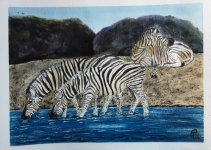Cindy - IMO, the zebras are well painted! Anything equine is notoriously difficult, and doing three of them is really laudable. The body shading is nice. The way you portrayed thinner stripes for the legs and as they were receding down the body is convincing. Also, the one resting has lighter stripes, which pushes it back. You may want to consider making the stripes of a mixture of browns and mixed "black" from complementary colors, saving the darkest "black" for the eyes. The mane may be warmer and color farther away from the head attachment, as light is shining through that area. Of course, cool colors recede, so that is a good idea. Possibly what is taking away from the zebras is the very dark land masses the are too similar in size. The way they meet in the middle of the pale sky and form a "V" is drawing the viewer's eye away from the subjects. Plus the "V" points to the back of the zebra. The artist may want to pick one zebra to be the COI, even if the ref photo shows them all in equal detail.
I really applaud you for taking on such a difficult subject. Even though I enjoy painting animals, they are tough and it is frustrating more often than not.







